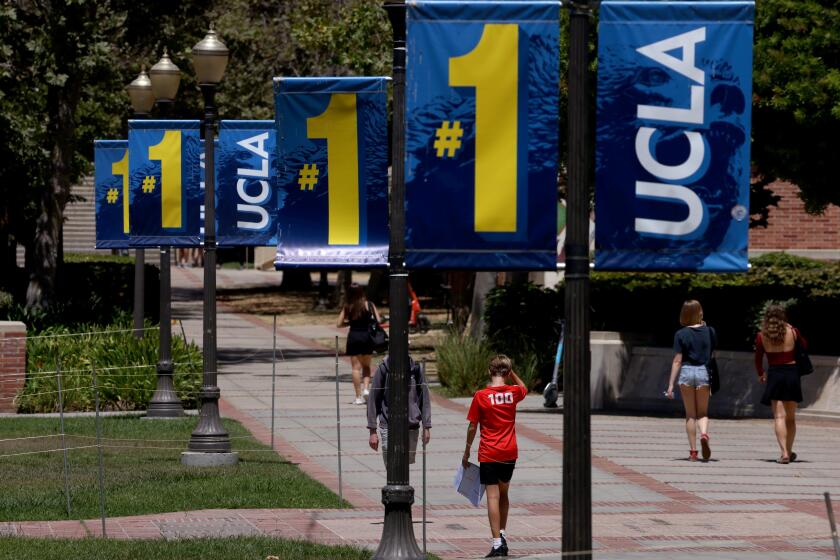When covered wagons crossed the plains,Their goal...
- Share via
When covered wagons crossed the plains,
Their goal the Golden West,
In search of homes the pioneers
Began their lonely quest.
The Valley of San Gabriel
With verdant beauty blest
Was chosen as the future home of Rosemead.
--”Song of Rosemead,” by A.M.
Foerster, 1932
*
As recently as the 1930s, even after America had moved beyond electrification, indoor plumbing and dial telephones, Rosemead was so distant from the central communications hub of Los Angeles that one resident put together a flock of carrier pigeons to tell his wife if he was going to be home late.
Part of the area was owned in the late 1800s by entrepreneur Leonard John Rose, a member of the Southern California Agriculture Society that brought horse racing to what today is Exposition Park. Rosemead was an outgrowth of Rose’s horse-breeding farm and vineyards.
German-born Rose began his career by riding riverboats down the Mississippi and trading apples for horses. In 1861, after Rose and his wife, Amanda, arrived in Los Angeles, they purchased 500 acres bounded by what today are Walnut Grove and Garvey avenues, Rosemead Boulevard and the San Bernardino Freeway.
Over the next four decades Rose’s ranch would grow to more than 1,000 acres, including 750 acres of vineyards and 175 acres of citrus and other fruit trees. It was here that he raised trotting and Thoroughbred racehorses and built a widely acclaimed racetrack and stable he called Rosemeade Stock Farm. But it would be his Sunny- slope vineyard in the Pasadena and San Marino area that would become his most successful venture, producing 500,000 gallons of wine and 150,000 gallons of brandy yearly.
After Rose served a short term in the state Senate in 1887, friends urged him to seek the Democratic nomination for Congress. His opponent was George S. Patton, who would later become the father of the general. But But after the 115th ballot, the convention gave up and decided on a different, compromise candidate. In 1899, at the age of 72, Rose, plagued with misfortune from bad investments, shot and killed himself.
In the years after Rose’s death, the area consisted mostly of hayfields, truck gardens, orchards, dairy and chicken farms and the 33-acre horse ranch called Edgemont Park, owned by department store founder J.W. Robinson.
By 1922, over the protests of 365 residents, a grocery store with one gas pump opened at Valley and Rosemead boulevards. Soon other merchants opened stores.
After almost a decade of cityhood efforts, Rosemead was finally incorporated in 1959.
Rosemead’s convenient location was exploited by Southern California Edison Co. in 1973, when it moved its headquarters and 8,000 employees from downtown Los Angeles. Today, more than 52,000 people and 1,100 businesses call the community home.
We welcome all who enter at our door.
They come from every state and distant shore.
So we sing the chorus, let us sing it evermore,
We’ll never find a better home than Rosemead.
(BEGIN TEXT OF INFOBOX / INFOGRAPHIC)
By the Numbers
CITY BUSINESS
Date incorporated: Aug. 4, 1959
Area in square miles: 5.5
Number of parks: 6
Number of city employees: 31 fulltime; 17 part time
1995-96 operating budget: $9 million
****
ETHNIC MAKEUP
Latino: 50%
White: 16%
Asian: 34%
Black: .5%
Other: .4%
****
PEOPLE
Population: 51,638
Households: 13,874
Average hopusehold size: 4
Median age: 29
****
MONEY AND WORK
Median household income: $29,770
Median household income/LA County: $34,965
Median home value: $193,000
Employed workers (16 and older): 23,124
Women in labor force: 50%
Men in labor force: 73%
Self-employed: 1,229
Car-poolers: 3,891
****
FAMILIES
Married couple families with children: 53%
Married couple families with no children: 19%
Other types of families: 20%
Nonfamily households: 9%
****
1989 HOUSEHOLD INCOME:
$0 to $14,999: 24%
$15,000 to $24,999: 18%
$25,000 to $49,999: 33%
$50,000 to $74,999: 16%
$75,000 to $99,999: 6%
$100,000 or more: 3%
****
RETAIL STORES
Total stores: 338
Total employees: 2,250
Annual sales: $237 million
Source: Claritas Inc. retail figures are for 1995. All other figures are for 1990. Percentages have been rounded to the nearest whole number.
More to Read
Sign up for Essential California
The most important California stories and recommendations in your inbox every morning.
You may occasionally receive promotional content from the Los Angeles Times.













